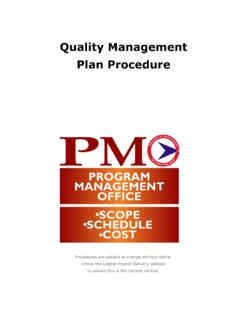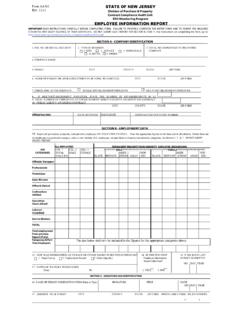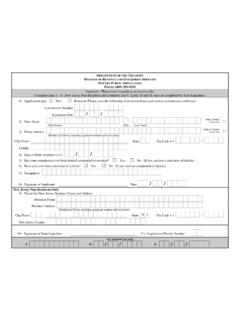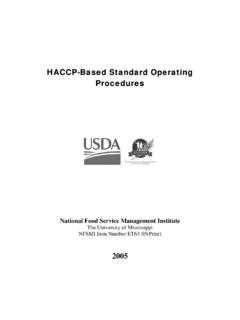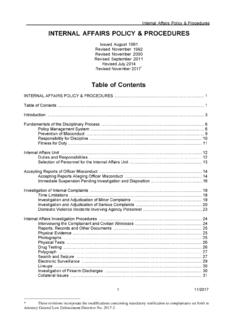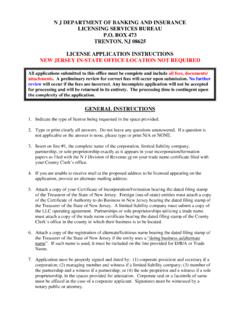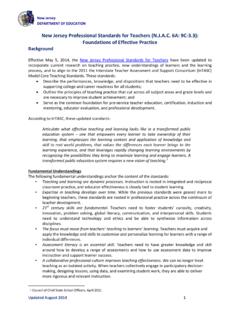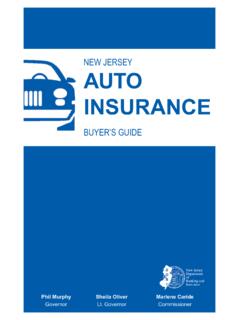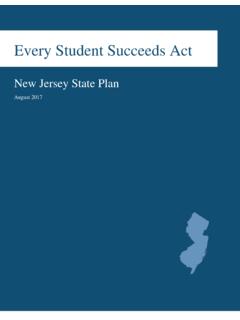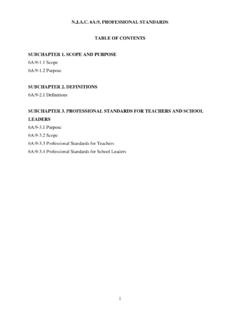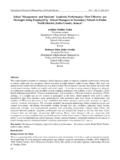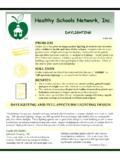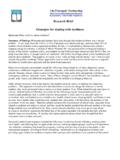Transcription of Guidance for Reporting Student Absences and …
1 Guidance for Reporting Student Absences and calculating chronic absenteeism May 2020 This document includes information on Reporting attendance for the period of State-mandated closure of schools to students per Executive Orders 104 and 107 (Murphy) (2020). 2 Guidance for Reporting Student Absences and calculating chronic absenteeism In order for students to learn and achieve their fullest potential, it is critical that they are in school and engaged in the learning process. Research shows that Student Absences impact a child s ability to succeed in school. In addition, research shows that chronic absenteeism from school is a primary cause of low academic achievement and a powerful predictor of a Student s risk of dropping out of school.
2 1 With the Every Student Succeeds Act (ESSA), the latest reauthorization of the Elementary and Secondary Education Act on December 10, 2015, the New Jersey Department of Education has identified chronic absenteeism as its indicator of school quality and Student success for accountability (see approved ESSA State Plan). chronic absenteeism is factored into the summative rating used to identify schools in need of comprehensive and targeted support and improvement. Additionally, school-level chronic absenteeism is included in each district s annual School Performance Reports for kindergarten through grade 12, per ESSA Note: The New Jersey Department of Education received a waiver from the United States Department of Education (USDOE) and is not required to report chronic absenteeism data for the purposes of accountability Reporting to the United States Department of Education for the 2019-2020 school year.
3 Under the waiver, 2019-20 School Performance Reports will not include chronic absenteeism , among other elements impacted by COVID-19. Additionally, USDOE waived the requirements that NJDOE annually meaningfully differentiate all public schools and the requirements to identify schools for comprehensive and targeted support and improvement based on data from the 2019-20 school year. This Guidance clarifies policies and expectations for Reporting Student membership and attendance data in NJ SMART and the methodology for measuring chronic absenteeism . Districts should review their locally developed attendance data collection system or work with their Student Information System (SIS) vendors to make sure they are in compliance with attendance Reporting requirements as outlined in this Guidance .
4 Additional information is included in this Guidance to address the period of the school year covered by Governor Murphy s executive order due to the COVID-19 pandemic. With more accurate data on Student attendance, schools and districts can use this information to better identify the root causes of chronic absence and implement improvement strategies to address these issues. A list of various research-based strategies for reducing chronic absenteeism is available on the NJDOE website. In a March 13, 2020 NJDOE Memo, Guidance Regarding Requirements for Public Health-Related School Closure, NJDOE indicated to districts that [a]ny day on which all students impacted by a public health-related closure have access to home instruction services provided consistent with the Guidance in this 1 Balfanz, R.
5 And Byrnes, V. (2012). The Importance of Being in School: A Report on absenteeism in the Nation s Public Schools. Baltimore: John Hopkins University Center for Social Organization of Schools. 3 memo will count as a day on which the board of education has provided public school facilities toward its compliance with the 180-day requirement in accordance with 18A:7F-9. Definitions chronic absenteeism is defined in New Jersey s ESSA State Plan as the percentage of a school s students who are not present for 10 percent or more of the days that they were in membership at a school. Cumulative Days in Membership is an element in NJ SMART defined as the number of school days in session in which a Student is enrolled/registered during the annual Reporting period from July 1 through June 30.
6 The count will commence the first day the Student is expected to start, even if he or she does not actually attend that day. School Day in Session is a day on which the school is open and students are under the Guidance and direction of a teacher(s); and the day must be 4 hours or more to be considered a full day (or at least 2 hours for kindergarten) ( 6 (a) and (b)). o The number of possible days in session for a Student on home instruction is the same as for other students in the program in which the Student is enrolled ( 6 (f)). o Schools must be in session a minimum of 180 days. o The number of school days in session does not include summer school. o The extended school year is included in the calculation up to June 30 and only when it is required for all students .
7 Five allowable reasons for absence : A school may have a day in session that would not be counted as a day in membership for a particular Student for the following reasons (New Jersey School Register, ): o Religious observance ( 6 (h)); o A college visit (up to 3 days per school year, only for students in grades 11 and 12); o Take Our Children to Work Day (pursuant to the memo issued by the Commissioner to all districts on April 25, 2017) or other rule issued by the Commissioner; o Participation in observance of Veterans Day ( 18A: ) or district board of election membership activities ( 18A: 36-33); or o The closure of a busing district that prevents a Student from having transportation to the receiving school. Cumulative Days Present is an element in NJ SMART defined as the number of school days a Student is present (not absent) when the school is in session during the annual Reporting period (July 1 through June 30) and the Student is recorded under the Guidance and direction of a teacher in the teaching process ( 6 ).
8 Whether a Student absence is due to illness, disciplinary action, or other reason, the Student may not be considered present at school unless home instruction is received. (For further clarification, see sections below on whether students can be recorded as present during school-sponsored programs and suspensions.) A Student with an excused absence per district board of education policy can NEVER be considered as present. 4 Time present Full Day: For a school in session during morning and afternoon, the Student must be present for at least one hour in the morning and at least one hour in the afternoon to be considered as present for a full day; for a school in session during either morning or afternoon, the Student must be present at least two hours to be recorded as present for the full day ( 6 (k)), for example, twilight programs.
9 For a half day preschool or kindergarten session, the Student must be present for at least one hour to be considered present for a full day. o NOTE: In 2019, USDOE has defined absence for State Reporting on chronic absenteeism as the following: students should be considered absent when they are not physically on school grounds or not participating in instruction or instruction-related activities at an approved off-grounds location for at least half the school day. NJDOE will be reviewing the state s administrative code and making changes as necessary. Districts will be informed of any changes and the impact on Reporting for chronic absenteeism . Time present Half Day: A Student must be present at least one hour during any morning, afternoon, or evening session to be recorded as present one-half day (New Jersey School Register, ).
10 Home instruction: A Student receiving home instruction is considered present and in membership under the following circumstances: o A Student with a temporary or chronic health condition receives home instruction by a certified teacher for the number of days and length of time sufficient to continue the Student s academic progress. A Student with a disability must receive home instruction consistent with the Student s individualized education program ( 6 ). As relayed in the NJDOE s March 5, March 13, and May 5 broadcast memos regarding school district public-health related school closure plans, the NJDOE cites this regulation regarding home instruction for students with a temporary or chronic health condition as a guidepost for districts in developing remote instruction plan.
